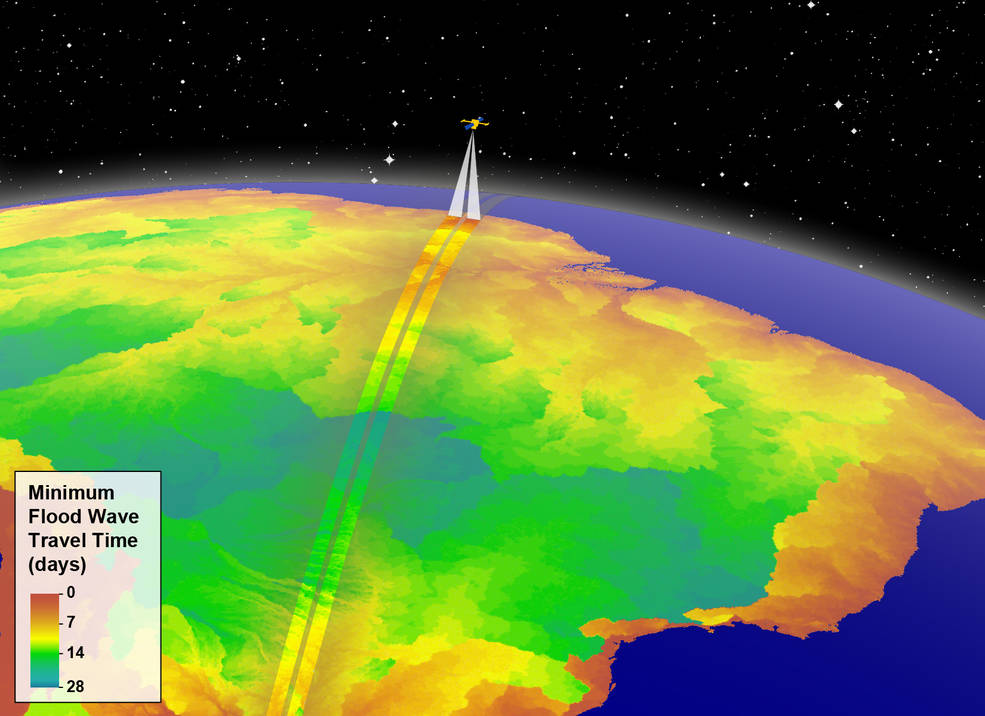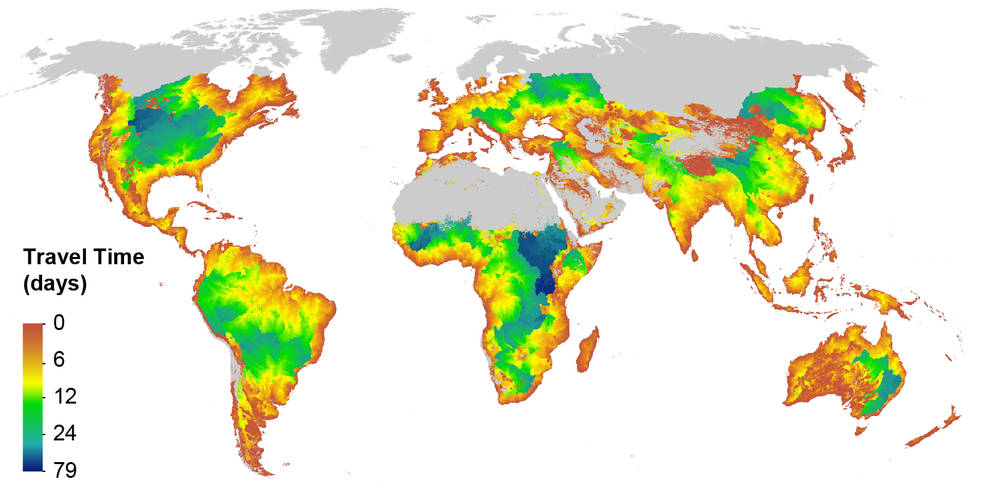26 April 2018
Satellites could further help mitigate river floods
Posted by Nanci Bompey
By Maria-José Viñas
River floods are one of the most common and devastating of Earth’s natural disasters. In the past decade, deluges from rivers have killed thousands of people every year around the world and caused losses on the order of tens of billions of U.S. dollars annually. Climate change, which is projected to increase precipitation in certain areas of the planet, might make river floods in these places more frequent and severe in the coming decades.
Now, a new study in Geophysical Research Letters, a journal of the American Geophysical Union, analyzes what it would take for river-observing satellites to become an even more useful tool to mitigate flood damage and improve reservoir management globally in near real-time.
“Early flood warning systems traditionally depend on gauge networks that detect floods farther up the river, but gauge data are becoming more and more scarce,” said George Allen, lead author of the new research and a hydrologist at NASA’s Jet Propulsion Laboratory in Pasadena, California. “Our study shows that there’s room for satellites to help fill in the gap. But for satellites to inform real-time flood mitigation, they have to provide data to water managers within a sufficiently short lag time.”

Artist’s illustration of NASA’s planned Surface Water and Ocean Topography (SWOT) satellite over the Amazon basin. The colors depict estimated minimum times for flood waves to travel downstream and reach the ocean, data that can inform requirements of satellites like SWOT that can detect floods. Credits: NASA/JPL-Caltech
River floods occur when a channel fills with water beyond the capacity of its banks, normally due to heavy rainfall. The flood travels along the course of the river as a wave, moving downstream faster than the water itself. Several satellite missions have been able to detect floods as a sudden change in the height or width of river waters. Once a flood is observed, it is relatively easy to accurately predict how it will move down the river. This information is extremely useful in early flood warning systems and other real-time river management applications.
To study the speed at which floods propagate through the planet’s rivers, Allen and his colleagues ran a simple numerical model of flow waves that used information such as the width, slope, depth and roughness — the amount of friction water experiences when traveling along a river — of rivers worldwide. After analyzing wave speeds through 11 million miles (17.7 million kilometers) of rivers around the planet, the researchers found that flood waves traveling at their maximum speed take a median time of three days to reach the next downstream dam, four days to arrive to the next downstream city and six days to exit the river system entirely.
The team compared their model’s results with discharge records from more than 20,000 United States Geological Survey gauge stations along around 40,000 miles (64.4 thousand kilometers) of varied river systems in the United States. They found that the model estimated faster wave speeds than what the gauge data showed.
“That was expected, based on the fact that we’re modeling waves moving at maximum speeds, whereas the gauge data are looking at all types of wave speeds: low speeds, high speeds, everything in between,” Allen said. “In this way, our study estimates a worst-case-scenario of how fast floods can move down rivers.”

Global map of the minimum times it takes flood waves to exit the global river network. Such information can be used to develop data requirements for satellites that can detect floods, for applications in making real-time river management decisions.
Credits: NASA/JPL-Caltech
The scientists then used their wave speed findings to calculate data latency — how quickly satellite data should be downloaded, processed and made available to the public to be useful for flood early warning systems and other real-time flood mitigation strategies, as well as reservoir management. In particular, they focused on future data from NASA’s upcoming Surface Water and Ocean Topography (SWOT) mission. SWOT, scheduled to launch in 2021, is specifically designed to observe rivers. That’s because it has a repeat orbit of 21 days and will be able to detect flood waves, particularly in higher-latitude large rivers, which SWOT will sample more often. The researchers found that making SWOT data available within days after being acquired by the spacecraft could be useful for real-time flood mitigation. Compared to past or current satellites providing river and flood information, SWOT will provide never-before-seen maps of river height, allowing for more reliable prediction of flood timing and magnitude.
If the data were to be processed in two days or less, Allen’s team calculated, it would be ready for emergency managers before at least two-thirds of observed waves reached the next downstream city. For dams, the quick turnaround of satellite measurements would give advance notice to downstream reservoirs in at least half of the cases when a flood wave is detected by SWOT.
“There is a trade-off between data latency and data quality,” said Cédric David of JPL, who directed the new study and is a member of SWOT’s science team. “So, do we want to wait to get the best data possible, or do we want to get a rough version of what’s going on now, so we can provide actionable information? As we prepare for new satellite missions like SWOT, that’s when we start asking these types of questions.”
Satellite data that could inform flood early warning systems would be particularly useful for developing nations, where there either are insufficient river gauges or where countries do not share gauge data with their downstream neighbors, Allen said.
— Maria-José Viñas is a science writer with NASA’s Earth science news team. This post originally appeared on the NASA JPL website.










 GeoSpace is a blog on Earth and space science, managed by AGU’s Public Information staff. The blog features posts by AGU writers and guest contributors on all sorts of relevant science topics, but with a focus on new research and geo and space sciences-related stories that are currently in the news.
GeoSpace is a blog on Earth and space science, managed by AGU’s Public Information staff. The blog features posts by AGU writers and guest contributors on all sorts of relevant science topics, but with a focus on new research and geo and space sciences-related stories that are currently in the news.
Interesting concept. It’s nice that it has a 21 turn around orbit, but I wonder if the same concept could be put to maybe a smaller, less mobile unit that could be stationary over those areas that experience possible flooding, like the burn areas of Southern California. Or maybe some that could be subject to control of movement. It is a good concept that be used as preventative danger instead of just gathering data after he fact.